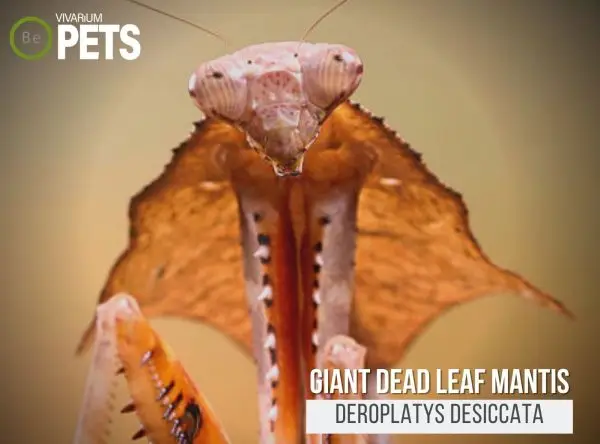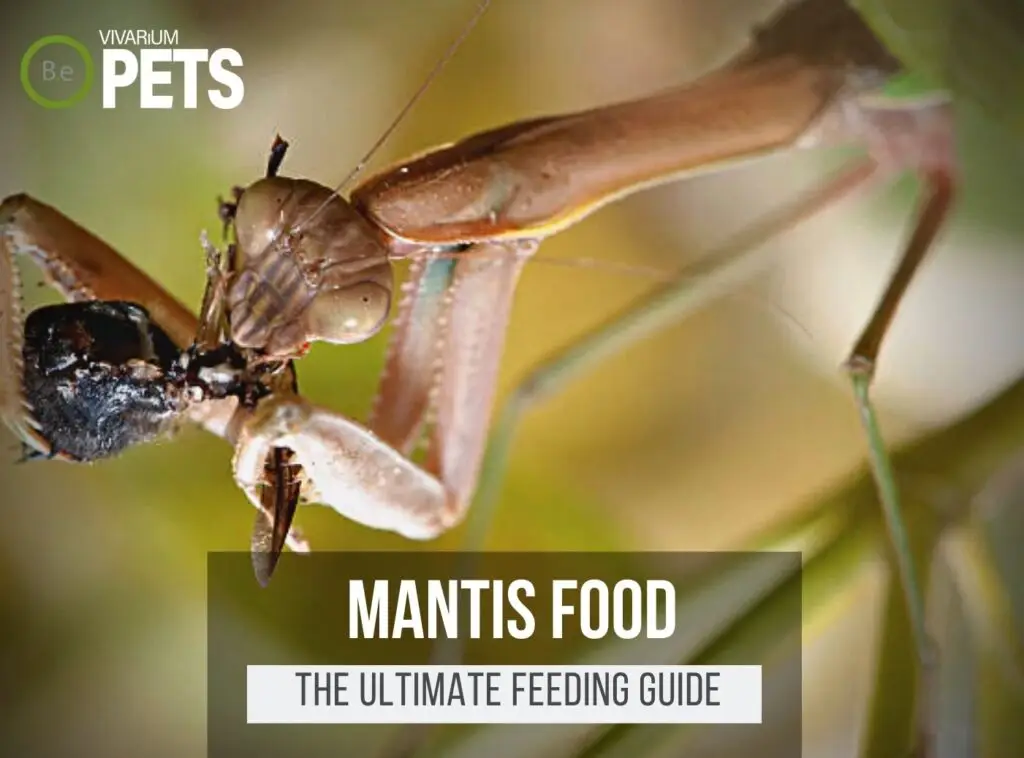Are you looking for an exotic addition to your mantid collection? Then the Giant Dead Leaf Mantis is the perfect choice.
These fascinating insects, native to Southeast Asia, are relatively easy to care for and make a great pet praying mantis for experienced mantid keepers.
In this Deroplatys desiccata guide, we’ll give you insight into their unique biology, setup, care, and feeding needs.
| Characteristics: | |
|---|---|
| Common Name | Giant Dead Leaf Mantis |
| Family Name | Deroplatyidae |
| Scientific Name | Deroplatys desiccata |
| Use | Pets |
| Temperament | Non-aggressive |
| Lifespan | 8 to 12 Months |
| Diet | Insectivore |
| Adult Size | 3-4 in |
| Breeding Type | Egg Layer |
| Care Level | Moderate |
| Minimum Tank Size | 5 Gallons |
| pH | 6.5-7.5 |
| Hardness | Moderate |
| Temperature | 80-85°F |
Table Of Contents:
ToggleWhat Are Giant Dead Leaf Mantises?
Deroplatys desiccata are large predatory insects that belong to the Dead Leaf Mantis family, Deroplatyidae.
They are native to Southeast Asia and get their common name from their unique ability to mimic a fallen decaying leaf for camouflage.
This species of mantis can reach up to a few inches long in adulthood and is easily recognizable by its brown and yellow coloration.
Furthermore, they have distinctive frilly antennae and gripping raptorial forearms.
What Do Giant Dead Leaf Mantises Look Like?
Giant Dead Leaf Mantises are large mantid insects, which can reach up to 4 inches in length depending on the gender.
They have an elongated body with a broad shield-like pronotum that protects their head and thorax, and two long, spiny raptorial forelegs.
Deroplatys desiccata are usually a brown color, although the exact shade can vary from individual to individual.
They possess large, intricate compound eyes, and have a long, thin abdominal segment with a pair of small cerci.
On the abdomen, you will find two long, flexible cerci that look much like antennae.
These mantises also have an interesting camouflage body.
During the day, they will tuck their forelegs up, so they resemble a dry dead leaf.
This helps the mantis hide from predators, but also from its prey.
When an insect passes close by, the mantis will slowly unfold its long raptorial forelegs and snatch up the insect for a meal.
Benefits Of Using Giant Dead Leaf Mantises
Giant Dead Leaf Mantises are an excellent inhabitant to many types of vivariums.
They have a very interesting shape and coloration — from a distance, they look just like dead leaves!
Their nocturnal nature means that they will be active and will help to enliven your tank after dark.
Plus, their predatory nature will help control any pest populations in your enclosure and keep it clean and healthy.
Finally, their unique morphology and behavior make them incredibly fun to watch and study, giving you hours of fascinating viewing.

Giant Dead Leaf Mantis Facts
Deroplatys desiccata are Southeast Asian natives that make fascinating pets due to their unique appearance and strong predatory behavior.
These enigmatic creatures have a lifespan of up to a year, and spend the majority of their life in the wild feeding on small insects.
Though they might be difficult to breed in captivity, they have a relatively calm temperament, making them easy to manage.
Habitat
Giant Dead Leaf Mantis is native to Southeast Asia, from Vietnam to Indonesia and Malaysia.
They prefer the dry forests of these regions, where they blend in perfectly with the dead leaves and shells of tree bark on the forest floor.
These insects also prefer to live in the higher canopy of these forests, where temperatures can remain consistent year-round.
With their bodies adapted to blend into the dead leaves and other foliage on the forest floor, they are nearly invisible in their native environment.
They use their remarkably long antennae to detect potential prey while relying on their flattened bodies to escape predators.
Diet
Deroplatys desiccata feed mainly on small insects such as flies and roaches.
In the wild they usually hunt by ambush, waiting for prey to come close before striking with their spiny forelegs.
They can also be seen feeding very occasionally on nectar or edible plants, but this is a rare activity.
Temperament
Giant Dead Leaf Mantises have a generally calm temperament, making them excellent pets for novice keepers.
They will express their interest in other creatures by making antennae contact and orienting their heads toward them.
Despite this curiosity, they are not likely to react in any aggressive manner and instead remain still and unresponsive.
While they aren’t typically aggressive, they will bite if picked up, so it is best to handle them with care.
Mantises are solitary animals, and therefore should not be housed together.
When kept alone, they will not react to other animals or insects that come near their enclosures.
However, if two mantises are housed together, they may fight or become cannibalistic.
This can be very stressful for both animals, and it is best to avoid housing them together.
Lifespan
Deroplatys desiccata is a relatively long-lived species, with some individuals living up to more than one year with proper care.
They spend the majority of their life as adults, though the length of the adult phase depends on their diet and environment.
Like other mantid species, Giant Dead Leaf Mantises undergoes three main stages of life: egg, nymph, and adult.
The female mantis lays her eggs in a foamy ootheca, which she then hides in crevices to protect them from predators.
After hatching, the nymphs undergo five to seven instar stages, with every stage bringing a complete exterior molt.
Finally, the insect transforms into its adult stage.
Adult D. desiccata are strong and agile fliers, with most preferring to perch on foliage and await their prey.
Breeding
Giant Dead Leaf Mantids reach sexual maturity at about 6–8 months.
During the mating process, the male and female grapple with each other, using their specialized forearms while the male attempts to transfer sperm to the female.
Once the mating is complete, the female will begin to produce an ootheca, or egg case, which can contain up to 80 eggs.
The female will attach the ootheca to a branch or leaf stem and guard it until it hatches.
Once hatched, the young mantids are called nymphs and pass through several stages known as instars before reaching adulthood, molting several times until maturity.
The nymphs are difficult to care for, requiring tiny prey and careful monitoring of humidity levels.
Where To Find Giant Dead Leaf Mantises
If you’re looking for a Giant Dead Leaf Mantis, you’ll have several different options.
The first is to search for them in their natural habitats, which are tropical forests in Southeast Asia.
If you’re lucky and have access to these areas, you may be able to find them yourself.
However, due to the difficulty associated with locating wild specimens, many people opt to purchase one from a reputable breeder.
Deroplatys desiccata is widely available from pet stores and online retailers, often in colors ranging from tan to deep brown.
While it may be tempting to buy a wild-caught specimen, it’s best to stick with captive-bred mantises as they are less likely to contain parasites or other health issues.
Giant Dead Leaf Mantis Care
Deroplatys desiccata can make great pets for experienced keepers.
To care for them correctly, provide an appropriate habitat, including a proper housing, substrate, water and humidity, temperature and lighting.
Feed them a variety of small insects, handle them with caution, and provide regular hygiene and maintenance as needed.
Tank Requirements
The ideal vivarium for Giant Dead Leaf Mantises should be a terrarium or a standard 5-10 gallon paludarium setup with a screened lid.
The ideal temperature for a tank should be consistently kept between 80-85 °F.
To keep the humidity at the proper levels, the terrarium substrate should be dampened with a spray bottle every few days.
A substrate of peat moss and coconut fiber soil mixed with a pH between 6.5–7.5 is recommended.
As for terarium lighting, UVB is not typically necessary, but should be provided if the temperature doesn’t exceed 70°F.
Choose a fluorescent bulb or a low-wattage incandescent lamp to provide your mantis with 12-14 hours of direct light each day.
What Does A Giant Dead Leaf Mantis Eat?
Giant Dead Leaf Mantises are generally opportunistic eaters.
The insects feed on a variety of invertebrates such as flies, moths, grasshoppers, crickets, and waxworms.
Offer an appropriate-sized animal twice per week for larvae and adults. Some good species of mantis food include:
• Crickets
• Mealworms
• Locusts
• Roaches
• Waxworms
• Fruit flies
• Moths
• Grasshoppers
• Beetles
• Silverfish
Place food items inside the enclosure if possible and before introducing live prey, make sure to offer a processed mantis food as well.
For the best results, gut-load larger feeder insects with a variety of fruits and vegetables for added nutrients.
If you’re looking for a more detailed approach to feeding these critters, be sure to check out my ultimate DIY Praying Mantis food guide. I give a more in-depth explanation of the best foods and my favorite recipe.
Best Tankmates For Giant Dead Leaf Mantises
Deroplatys desiccata is a solitary species that should not be kept with other mantids.
However, they do appreciate a bit of company and can be kept with beneficial tankmates like hissing cockroaches, woodlice, and small prey items.
Additionally, some harmless spiders like a spiderling jumping spider or lynx spider, can be beneficial tankmates for the Giant Dead Leaf Mantis as they help remove mites from the enclosure.
As for larger invertebrates, small millipedes, earthworms, and crickets may make good tank partners as well.
Keep in mind that overpopulation can lead to stress so be sure to keep an eye on the sizes of your tankmates and remove any that become too large or numerous for D. desiccata.
Conclusion
In conclusion, Giant Dead Leaf Mantises are a fascinating species of mantis that make great pets for experienced keepers.
With the right setup and care, you can easily create an optimum habitat for your pet.
From essential housing needs to hygiene and maintenance, this care guide has given you a comprehensive overview of the needs of these fascinating insects, so you can give your pet the best care possible.
Frequently Asked Questions
Giant Dead Leaf Mantises (Deroplatys desiccata) typically reach a size of around 3 to 4 inches (7.6 to 10.2 centimeters) in length.

